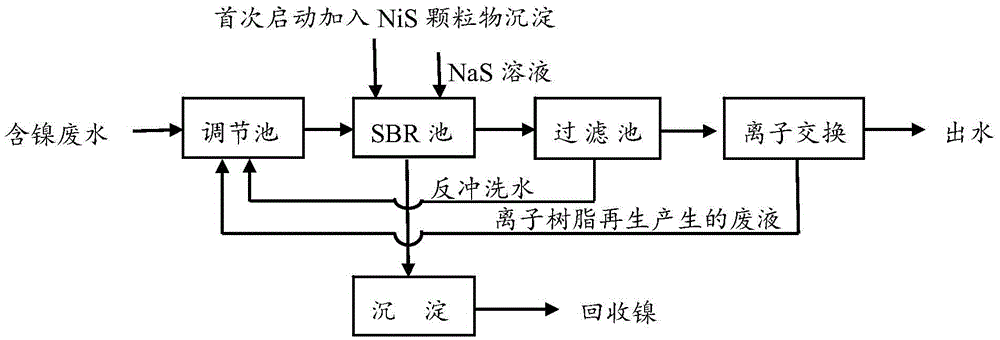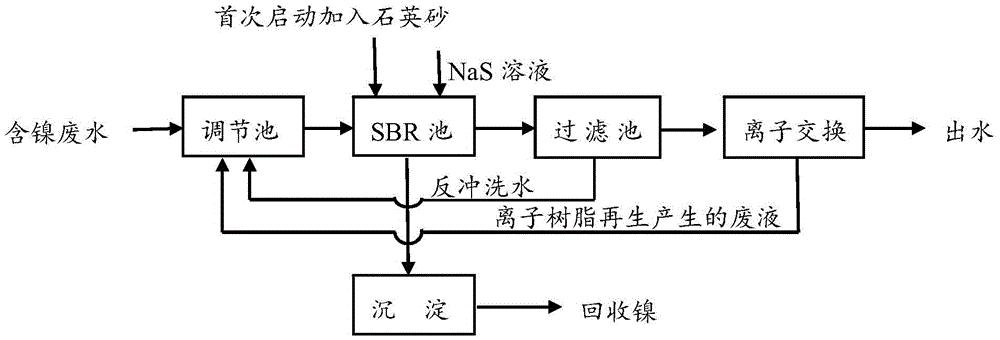Treatment method of heavy metal wastewater
A treatment method and technology for heavy metals, applied in water/sewage treatment, special compound water treatment, water/sludge/sewage treatment, etc. problem, to achieve the effect of favorable recovery and fast settling speed
- Summary
- Abstract
- Description
- Claims
- Application Information
AI Technical Summary
Problems solved by technology
Method used
Image
Examples
Embodiment 1
[0046] Embodiment 1: a kind of processing method of heavy metal wastewater
[0047] For nickel-containing waste water with a nickel concentration of 600mg / L in the influent, sodium sulfide solution is added, and the nickel-containing waste water and sodium sulfide solution react in the SBR reactor or reaction tank to generate particulate matter. The molar ratio of nickel and sulfur is It is 1:1.2, stirring for 5 minutes, and standing for 2h.
[0048] Accelerate the rapid precipitation of small particles and other substances under the coercion of particles, and realize the evolutionary treatment of wastewater after standing still.
Embodiment 2
[0049] Embodiment 2: A kind of processing method of sequencing batch type heavy metal wastewater
[0050] For nickel-containing waste water with a nickel concentration of 600mg / L in the influent, sodium sulfide solution is added, and the nickel-containing waste water and sodium sulfide solution react in the SBR reactor or reaction tank to generate particulate matter. The molar ratio of nickel and sulfur is It is 1:1.2, the system flow chart is as follows figure 1 shown.
[0051] During the start-up phase of the system, nickel sulfide is added to precipitate particles, and the dosing ratio is 10% of the solution volume. After the system is started, the bottom mud is used to re-mix. Using this method, the precipitated particles can significantly increase the settling velocity of other particles in the solution. Larger particles can accelerate the settling rate of smaller particles. After precipitation for 30 minutes, the obtained supernatant has a nickel concentration of 30-40...
Embodiment 3
[0052] Embodiment 3: A kind of processing method of sequencing batch type heavy metal wastewater
[0053] For nickel-containing waste water with a nickel concentration of 600mg / L in the influent, sodium sulfide solution is added, and the nickel-containing waste water and sodium sulfide solution react in the SBR reactor or reaction tank to generate particulate matter. The molar ratio of nickel and sulfur is It is 1:1.0, the system flow chart is as follows figure 2 shown.
[0054] During the start-up stage of the system, quartz sand is added, and the dosing ratio is 30% of the solution volume. After the system is started, the bottom mud is used to re-mix. Using this method, the sedimentation of particles can significantly increase the settling velocity of other particles in the solution. Particulate matter can accelerate the settling rate of small particles. After precipitation for 30 minutes, the obtained supernatant has a nickel concentration of 30-40 mg / L. The precipitate...
PUM
 Login to View More
Login to View More Abstract
Description
Claims
Application Information
 Login to View More
Login to View More - R&D
- Intellectual Property
- Life Sciences
- Materials
- Tech Scout
- Unparalleled Data Quality
- Higher Quality Content
- 60% Fewer Hallucinations
Browse by: Latest US Patents, China's latest patents, Technical Efficacy Thesaurus, Application Domain, Technology Topic, Popular Technical Reports.
© 2025 PatSnap. All rights reserved.Legal|Privacy policy|Modern Slavery Act Transparency Statement|Sitemap|About US| Contact US: help@patsnap.com



